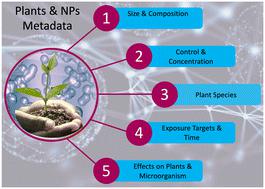当前位置:
X-MOL 学术
›
Environ. Sci.: Nano
›
论文详情
Our official English website, www.x-mol.net, welcomes your
feedback! (Note: you will need to create a separate account there.)
Are nanomaterials leading to more efficient agriculture? Outputs from 2009 to 2022 research metadata analysis
Environmental Science: Nano ( IF 5.8 ) Pub Date : 2022-08-19 , DOI: 10.1039/d1en01078f E. Santos 1 , G. S. Montanha 1, 2 , M. H. F. Gomes 1 , N. M. Duran 1 , C. G. Corrêa 1 , S. L. Z. Romeu 1 , A. E.S. Pereira 3 , J. L. Oliveira 3 , E. Almeida 1 , A. Pérez-de-Luque 4 , S. Ghoshal 5 , C. Santaella 6 , R. de Lima 7 , L. F. Fraceto 2 , H. W. P. Carvalho 1
Environmental Science: Nano ( IF 5.8 ) Pub Date : 2022-08-19 , DOI: 10.1039/d1en01078f E. Santos 1 , G. S. Montanha 1, 2 , M. H. F. Gomes 1 , N. M. Duran 1 , C. G. Corrêa 1 , S. L. Z. Romeu 1 , A. E.S. Pereira 3 , J. L. Oliveira 3 , E. Almeida 1 , A. Pérez-de-Luque 4 , S. Ghoshal 5 , C. Santaella 6 , R. de Lima 7 , L. F. Fraceto 2 , H. W. P. Carvalho 1
Affiliation

|
Agriculture is responsible for supplying food, feed, fibres, and an increasing fraction of fuel and raw chemicals for industry. Fulfilling such demands sustainably is one of the major challenges of our time. In this metadata analysis, we offer a quantitative overview of how scientists have been addressing the effects of nanomaterials on plants between 2009 and 2022. The analysis showed that cultivated crops (ca. 55%) and plant nutrients (54%) are mostly employed in the studies, pointing to the relevance of these aspects to agriculture. Nevertheless, it also revealed that the concentration of elements as nanomaterials is generally more than 2-fold higher than the elemental concentration applied as traditionally formulated fertilisers or those naturally found in soil. Furthermore, the median time span of most studies, i.e., 49 days for plants cultivated in soil, is still quite short compared to annual crop life cycles (90–120 days), and little attention (19% of treatments) has been devoted to soil microorganisms. Also, only a small fraction of experiments (6%) has been carried out under field conditions. Therefore, the data did not allow establishing correlations between effects and experimental parameters, such as concentration range, soil pH, or time of exposure. These observations point to the intricate relationship between our ability to infer conclusions and the experimental design employed. Finally, this comprehensive and up-to-date overview of the effects of nanomaterials on plant systems raises the question of whether nanomaterials will lead to incremental yield gains by replacing current inputs with nanotechnology-based ones, such as the controlled release of fertilizers and pesticides, or will disrupt agriculture by attacking problems so far not practically addressed, such as hacking plant stress and defence mechanisms or modulating metabolism and photosystems.
中文翻译:

纳米材料会带来更高效的农业吗?2009 年至 2022 年研究元数据分析的产出
农业负责为工业提供食品、饲料、纤维以及越来越多的燃料和原料化学品。可持续地满足这些需求是我们这个时代的主要挑战之一。在本元数据分析中,我们对 2009 年至 2022 年间科学家如何解决纳米材料对植物的影响进行了定量概述。分析表明,栽培作物 ( ca.55%) 和植物养分 (54%) 主要用于研究,指出这些方面与农业的相关性。尽管如此,它也表明,作为纳米材料的元素浓度通常比传统配方肥料或土壤中天然存在的元素浓度高出 2 倍以上。此外,大多数研究的中位时间跨度,即,在土壤中种植的植物需要 49 天,与一年生作物生命周期(90-120 天)相比仍然很短,而且很少关注(19% 的处理)对土壤微生物的关注。此外,只有一小部分实验(6%)是在野外条件下进行的。因此,数据不允许建立效应和实验参数之间的相关性,例如浓度范围、土壤 pH 值或暴露时间。这些观察结果指出了我们推断结论的能力与所采用的实验设计之间的复杂关系。最后,对纳米材料对植物系统影响的全面和最新概述提出了一个问题,即纳米材料是否会通过用基于纳米技术的投入替代当前的投入来增加产量,
更新日期:2022-08-19
中文翻译:

纳米材料会带来更高效的农业吗?2009 年至 2022 年研究元数据分析的产出
农业负责为工业提供食品、饲料、纤维以及越来越多的燃料和原料化学品。可持续地满足这些需求是我们这个时代的主要挑战之一。在本元数据分析中,我们对 2009 年至 2022 年间科学家如何解决纳米材料对植物的影响进行了定量概述。分析表明,栽培作物 ( ca.55%) 和植物养分 (54%) 主要用于研究,指出这些方面与农业的相关性。尽管如此,它也表明,作为纳米材料的元素浓度通常比传统配方肥料或土壤中天然存在的元素浓度高出 2 倍以上。此外,大多数研究的中位时间跨度,即,在土壤中种植的植物需要 49 天,与一年生作物生命周期(90-120 天)相比仍然很短,而且很少关注(19% 的处理)对土壤微生物的关注。此外,只有一小部分实验(6%)是在野外条件下进行的。因此,数据不允许建立效应和实验参数之间的相关性,例如浓度范围、土壤 pH 值或暴露时间。这些观察结果指出了我们推断结论的能力与所采用的实验设计之间的复杂关系。最后,对纳米材料对植物系统影响的全面和最新概述提出了一个问题,即纳米材料是否会通过用基于纳米技术的投入替代当前的投入来增加产量,











































 京公网安备 11010802027423号
京公网安备 11010802027423号